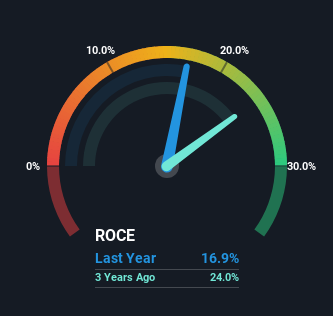- India
- /
- Healthcare Services
- /
- NSEI:KIMS
Investors Will Want Krishna Institute of Medical Sciences' (NSE:KIMS) Growth In ROCE To Persist

To find a multi-bagger stock, what are the underlying trends we should look for in a business? Firstly, we'll want to see a proven return on capital employed (ROCE) that is increasing, and secondly, an expanding base of capital employed. If you see this, it typically means it's a company with a great business model and plenty of profitable reinvestment opportunities. Speaking of which, we noticed some great changes in Krishna Institute of Medical Sciences' (NSE:KIMS) returns on capital, so let's have a look.
Return On Capital Employed (ROCE): What Is It?
For those who don't know, ROCE is a measure of a company's yearly pre-tax profit (its return), relative to the capital employed in the business. Analysts use this formula to calculate it for Krishna Institute of Medical Sciences:
Return on Capital Employed = Earnings Before Interest and Tax (EBIT) ÷ (Total Assets - Current Liabilities)
0.17 = ₹5.2b ÷ (₹34b - ₹3.6b) (Based on the trailing twelve months to September 2023).
So, Krishna Institute of Medical Sciences has an ROCE of 17%. In absolute terms, that's a satisfactory return, but compared to the Healthcare industry average of 13% it's much better.
Check out our latest analysis for Krishna Institute of Medical Sciences

Above you can see how the current ROCE for Krishna Institute of Medical Sciences compares to its prior returns on capital, but there's only so much you can tell from the past. If you'd like to see what analysts are forecasting going forward, you should check out our free report for Krishna Institute of Medical Sciences.
How Are Returns Trending?
The trends we've noticed at Krishna Institute of Medical Sciences are quite reassuring. The data shows that returns on capital have increased substantially over the last five years to 17%. Basically the business is earning more per dollar of capital invested and in addition to that, 443% more capital is being employed now too. This can indicate that there's plenty of opportunities to invest capital internally and at ever higher rates, a combination that's common among multi-baggers.
In another part of our analysis, we noticed that the company's ratio of current liabilities to total assets decreased to 11%, which broadly means the business is relying less on its suppliers or short-term creditors to fund its operations. So this improvement in ROCE has come from the business' underlying economics, which is great to see.
The Key Takeaway
All in all, it's terrific to see that Krishna Institute of Medical Sciences is reaping the rewards from prior investments and is growing its capital base. Since the stock has returned a solid 31% to shareholders over the last year, it's fair to say investors are beginning to recognize these changes. In light of that, we think it's worth looking further into this stock because if Krishna Institute of Medical Sciences can keep these trends up, it could have a bright future ahead.
If you want to continue researching Krishna Institute of Medical Sciences, you might be interested to know about the 1 warning sign that our analysis has discovered.
While Krishna Institute of Medical Sciences isn't earning the highest return, check out this free list of companies that are earning high returns on equity with solid balance sheets.
Valuation is complex, but we're here to simplify it.
Discover if Krishna Institute of Medical Sciences might be undervalued or overvalued with our detailed analysis, featuring fair value estimates, potential risks, dividends, insider trades, and its financial condition.
Access Free AnalysisHave feedback on this article? Concerned about the content? Get in touch with us directly. Alternatively, email editorial-team (at) simplywallst.com.
This article by Simply Wall St is general in nature. We provide commentary based on historical data and analyst forecasts only using an unbiased methodology and our articles are not intended to be financial advice. It does not constitute a recommendation to buy or sell any stock, and does not take account of your objectives, or your financial situation. We aim to bring you long-term focused analysis driven by fundamental data. Note that our analysis may not factor in the latest price-sensitive company announcements or qualitative material. Simply Wall St has no position in any stocks mentioned.
About NSEI:KIMS
Krishna Institute of Medical Sciences
Provides medical and health care services under the KIMS Hospitals brand name in India.
Exceptional growth potential and slightly overvalued.
Market Insights
Community Narratives




